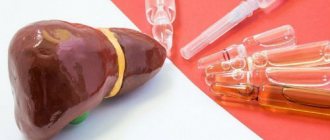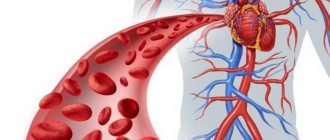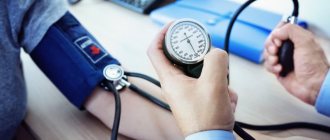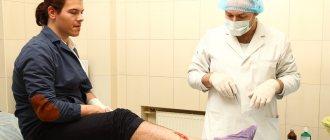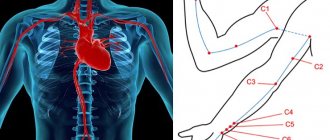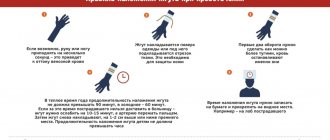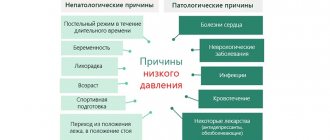Key questions: Definition and concept of diabetes. Normal blood glucose numbers. Glucose in urine. Glycated hemoglobin and fructosamines. C-peptide and other tests.
Diabetes mellitus is a group of diseases in which chronically elevated. Normally, fasting blood glucose levels are maintained between 3.3 and 5.5; after meals – up to 7.8 mmol/l.
There are other units for measuring blood glucose: mg/dL. To convert to mmol/l, the value in mg/dl must be divided by 18.
In the body, blood glucose levels are reduced by the hormone insulin , which is produced in the pancreas.
If little or no insulin is produced, or low-quality insulin is produced, or a person has had their pancreas removed, etc., the level of glucose in the blood rises and the person is diagnosed with diabetes mellitus.
Depending on the cause of the disease, the type of diabetes is determined (type 1, type 2, pancreatogenic, etc.).
In type 1 diabetes, insulin is not produced at all or very little is produced.
In type 2 diabetes mellitus, at the initial stage of the disease, insulin can be produced even in excess quantities, but its effect is weakened (due to a decrease in the body’s sensitivity to insulin or “low-quality” insulin).
In pancreatogenic diabetes, insulin is not produced after pancreatitis or removal of the pancreas.
These are the most common types of diabetes, but not all.
A separate condition is gestational diabetes mellitus, which develops in pregnant women and resolves after pregnancy.
The result is one: high blood glucose levels.
Classification of pathology
Depending on the cause of the disease, there are 2 main types of diabetes mellitus: insulin-dependent (type 1) and non-insulin-dependent (type 2). In insulin-dependent diabetes, the pancreas does not synthesize insulin or produces it in insufficient quantities, and in non-insulin-dependent diabetes, tissue sensitivity to insulin decreases.
Additionally, a distinction is made between secondary diabetes (develops against the background of other diseases) and gestational diabetes (occurs in pregnant women).
Depending on compensation, diabetes mellitus is:
- compensated - carbohydrate metabolism is normalized, and glucose concentration approaches normal;
- subcompensated – blood sugar levels periodically increase or decrease;
- decompensated - neither diet nor medications can lower glucose, which is why diabetics often develop precoma or coma, which can lead to death.
To successfully compensate for diabetes, it is important to regularly measure blood sugar levels and make timely adjustments to treatment.
Hypoglycemia
No less dangerous for a diabetic is the state of hypoglycemia (a decrease in glucose concentration to a critical level). The sugar level at which loss of consciousness occurs is 2.6 mmol/l. For a diabetic patient, this condition threatens hypoglycemic coma. In type 2 diabetes, an accelerated decrease in glucose levels occurs for the following reasons:
- non-compliance with diet;
- physical activity exceeding the patient's capabilities;
- excessive consumption of alcoholic beverages;
- incorrect dose of glucose-lowering medications taken (overdose);
- the presence of a hormonally active tumor (insulinoma).
The main symptoms of hypoglycemia are:
- dizziness, decreased blood pressure, cephalgic syndrome;
- psychoexcitability, unreasonable irritability and anxiety;
- decreased visual acuity and slowed speech;
- tremors in the limbs (tremor) and loss of coordination (ataxia);
- absent-mindedness;
- neuropsychological weakness (asthenia);
- convulsive syndrome;
- abnormal heart rhythm (tachycardia);
- nausea and vomiting.
Important! A sharp decrease in sugar causes extinction of brain activity (stuporous state) and fainting, followed by the development of coma. Lack of emergency medical care during an attack of hypoglycemia can cost a diabetic his life.
Degrees of diabetes
According to the WHO classification, there are 3 degrees of the disease:
- mild (glucose level does not exceed 7 mmol/l) - often occurs hidden, symptoms are absent or barely noticeable, complications do not arise;
- moderate (sugar concentration - 7-14 mmol/l) - complications are observed in the form of damage to the skin, blood vessels, heart, kidneys, eyes, nerves;
- severe (glucose level is in the range of 15-25 mmol/l, and sometimes higher) - severe complications occur (diabetic ulcers, kidney failure, gangrene of the extremities, diabetic coma), and death is possible.
Strict control over indicators
To avoid serious pathological changes, experts recommend that diabetics not only control hyperglycemia, but also not allow levels to drop below normal.
To do this, you should take measurements during the day at certain times, be sure to follow all the doctor’s instructions so that normal sugar levels are maintained:
- in the morning before meals – up to 6.1;
- 3-5 hours after a meal – no higher than 8.0;
- before going to bed – no higher than 7.5;
- urine test strips – 0-0.5%.
In addition, with non-insulin-dependent diabetes, mandatory weight adjustment is required so that it corresponds to the gender, height and proportions of the person.
You can use a special table, but it is advisable that it takes into account not only height, but also the age and gender of the person
Causes of the disease
The hereditary factor is of primary importance in the development of diabetes mellitus. Predisposition to the disease is transmitted through the maternal line in 5% of cases and through the father in 10% of cases. If both parents have diabetes, the risk of developing pathology reaches 100%.
Also, the main causes of non-insulin-dependent diabetes include:
- inactivity and overeating, leading to obesity - if body weight is 50% higher than normal, then the risk of increased glucose increases to 60%;
- poor nutrition.
The main causes of insulin-dependent diabetes:
- autoimmune diseases (lupus, autoimmune thyroiditis, glomerulonephritis, hepatitis);
- viral infections that destroy pancreatic beta cells responsible for the production of insulin (chickenpox, rubella, hepatitis, mumps).
Diabetes mellitus is a disease that develops as a result of a relative or absolute deficiency of insulin or a disruption of its interaction with the receptor, resulting in hyperglycemia. It is characterized by a chronic course and a violation of all types of metabolism: carbohydrate, fat, protein, mineral and water-salt.
Risk factors for developing diabetes:
- Presence of diabetes in 1st degree relatives (parents, brothers, sisters)
- Impaired fasting glucose or glucose tolerance at previous examination
- Other clinical conditions that are associated with impaired glucose tolerance
- Presence of cardiovascular diseases
- Low physical activity
- In women - polycystic ovary syndrome, birth of a child weighing more than 4 kg, gestational diabetes
- BP > 140/90 or therapy for hypertension
- HDL cholesterol < 0.9 mM/l and/or triglycerides > 2.82 mM/l
- Testing for prediabetes and diabetes in asymptomatic adults is indicated if they are overweight (BMI greater than 25 kg/m2) and have one or more risk factors for diabetes. If there are no additional risk factors, the test should be performed starting at age 45 at intervals of 3 years.
There are two main types of diabetes mellitus:
- Type 1 diabetes mellitus (insulin-dependent, IDDM) occurs in 10-15% of all diabetic patients. Hyperglycemia develops as a result of insulin deficiency caused by autoimmune destruction of insulin-producing β-cells of the pancreas. The peak incidence was observed at the ages of 3-5 and 11-14 years.
- Type 2 diabetes mellitus (non-insulin dependent, NIDDM) is much more common (80-85% of cases). Hyperglycemia is caused by insulin resistance. The risk of morbidity is observed after 50 years of life.
Main differences between both forms of diabetes
| IDDM ( type 1) | index | NIDDM ( type 2) |
| Up to 30 years old | Patient's age | After 50 years |
| Shortage | Body mass | 80-90% obesity |
| Acute | Onset of the disease | Gradual |
| Spring-winter period | Seasonality of the disease | Absent |
| Labile | Course of diabetes | Stable |
| Tendency to ketoacidosis | Ketoacidosis | Not developing |
| High hyperglycemia | Blood analysis | Moderate hyperglycemia |
| Reduced | Insulin and C-peptide in the blood | Normal, often elevated |
| Detected in 80-90% in the first weeks of the disease | Autoantibodies to the islets of Langerhans Autoantibodies to insulin Autoantibodies to glutamic acid decarboxylase | None |
| HLA DR3-B8, DR4-B15, C2-1, C4, A3, Dw4, DQw8 | Immunogenetics | No different from healthy ones |
In addition to type 1 and type 2 diabetes, there are other specific types of diabetes. Diabetes mellitus in such patients is a consequence of a certain primary disease (genetic or acquired), and this form of diabetes is often called secondary diabetes mellitus. The main causes are the following diseases:
- Genetic defects in β-cells or insulin action;
- Acromegaly (gigantism): GH interferes with the uptake of glucose into fat and muscle tissue by suppressing the action of insulin;
- Pheochromocytoma: the action of catecholamines is aimed at mobilizing glucose from the depot and suppressing the effects of insulin;
- Itsenko-Cushing syndrome: excessive secretion of cortisol inhibits glucose uptake in many tissues;
- Chronic pancreatitis or surgery on the pancreas causes tissue damage to the pancreas (including β-cells);
- Toxic effects on the pancreas of drugs and chemicals.
A normal pregnancy is accompanied by numerous hormonal changes that predispose to the development of hyperglycemia and, accordingly, to the development of diabetes. Up to 14% of pregnant women suffer from transient diabetes.
DIAGNOSIS OF DIABETES MELLITUS The task of a laboratory examination if diabetes is suspected is to identify or confirm the presence of absolute or relative insulin deficiency in the patient. The main biochemical signs of insulin deficiency are: fasting hyperglycemia or an abnormal increase in glucose levels after meals, glycosuria and ketonuria. In the absence of symptoms, laboratory results alone provide an accurate diagnosis. The WHO Expert Committee recommends screening for the presence of diabetes in the following categories of citizens: 1) All patients over the age of 45 years (if the test result is negative, it is repeated every three years). 2) Younger patients with:
- Obesity;
- Hereditary burden of diabetes;
- High-risk ethnic/racial background;
- History of gestational diabetes mellitus;
- The birth of a child weighing more than 4.5 kg;
- Arterial hypertension;
- Previously identified impaired glucose tolerance or high fasting glycemia;
Blood glucose testing Testing the concentration of glucose in the blood is the most common method for diagnosing diabetes. Glucose is evenly distributed between plasma and blood cells, with some excess of its concentration in plasma. The glucose content in arterial blood is higher than in venous blood, which is explained by the continuous use of glucose by the cells of tissues and organs. This explains the advantage of studying glucose in plasma or serum of venous blood over its determination in capillary blood for diagnosing diabetes. Venous blood additionally reflects such an important point as the use of glucose by cells of tissues and organs. Therefore, for the diagnosis of diabetes, it is preferable to determine glucose in venous blood.
Reference values for blood glucose concentrations
| Age | Glucose concentration in blood plasma, mmol/l | mg/dl |
| newborns | 2,8 — 4,4 | 50 — 115 |
| children | 3,9 — 5,8 | 70 — 105 |
| adults | 3,9 — 6,1 | 70 — 110 |
Glycosylated hemoglobin Glycosylated hemoglobin is formed as a result of a non-enzymatic reaction between hemoglobin A contained in red blood cells and serum glucose. The degree of glycosylation of hemoglobin depends on the concentration of glucose in the blood and on the duration of contact of glucose with hemoglobin (the lifespan of a red blood cell). Red blood cells circulating in the blood have different ages, therefore, to average the level of glucose associated with it, we focus on the half-life of red blood cells (60 days). There are at least three variants of glycosylated hemoglobins: HbA1a, HbA1b, HbA1c, but only the latter variant quantitatively predominates and gives a closer correlation with the severity of diabetes mellitus. The results of the study of glycosylated hemoglobin are assessed as follows:
- 4-6% indicate good compensation of diabetes in the last 1-2 months,
- 6.2-7.5% – satisfactory level,
- above 7.5% – unsatisfactory.
Unlike glucose, the level of glycosylated hemoglobin does not depend on physical activity, food intake, medications, or the patient’s emotions.
Relationship between blood glucose concentrations and glycosylated hemoglobin levels
| Glycosylated hemoglobin level | Blood glucose concentration | |
| mmol/l | mg/dl | |
| 4,0 | 2,6 | 50 |
| 5,0 | 4,7 | 80 |
| 6,0 | 6,3 | 115 |
| 7,0 | 8,2 | 150 |
| 8,0 | 10,0 | 180 |
| 9,0 | 11,9 | 215 |
| 10,0 | 13,7 | 250 |
| 11,0 | 15,6 | 280 |
| 12,0 | 17,4 | 315 |
| 13,0 | 19,3 | 350 |
| 14,0 | 21,1 | 380 |
Glucose tolerance test The most informative method for diagnosing diabetes is considered to be the dynamics of changes in the level of glucose in the blood of patients in response to a sugar load - the glucose tolerance test (glucose tolerance test). A glucose tolerance test should be performed in patients if the fasting plasma glucose level is from 6.1 to 7.0 nmol/l, as well as in persons with identified risk factors for the development of diabetes (diabetes mellitus in close relatives, birth of a large fetus, impaired tolerance history of glucose deficiency, obesity, hypertension). To carry out the test, the patient must receive a diet containing at least 125 g of carbohydrates for 3 days (all hospital food tables meet this requirement). The test is carried out in the morning after 10-14 hours of fasting. An initial blood sample is taken on an empty stomach, then the patient takes 75 g of glucose dissolved in 200 ml of water, and the child takes 1.75 g of glucose per 1 kg of weight, but not more than 75 g. The blood is taken again after 120 minutes and the samples are examined for glucose content (interpretation of test results, see below).
Examination of urine for glucosuria In healthy people, glucose entering the primary urine is almost completely reabsorbed in the renal tubules and is not determined in urine by conventional methods. When the glucose concentration increases above the renal threshold (8.88-9.99 mmol/l), glucose begins to enter the urine and glucosuria occurs. Glucose can be detected in the urine in two cases: with a significant increase in glycemia and with a decrease in the renal threshold for glucose - renal diabetes. In patients with diabetes mellitus, glucosuria is studied to assess the effectiveness of treatment and as an additional criterion for compensation of diabetes:
- In type 1 diabetes mellitus, urinary loss of 20-30 g of glucose per day is allowed.
- The criterion for compensation of type 2 diabetes mellitus is the achievement of aglucosuria.
Determination of glucose in urine is not usually used to diagnose diabetes mellitus. Moreover, with age, the renal threshold for glucose increases and in older people can be above 16.6 mmol/l before glucosuria appears.
Autoantibodies Currently, IDDM is considered an autoimmune disease with destruction of β-cells of the pancreatic islets. Inducers of the autoimmune process in type 1 diabetes mellitus include Coxsackie B viruses, mumps, encephalomyelitis, rubella, etc. The detection of autoantibodies to islet cell antigens has the greatest prognostic significance in the development of type 1 diabetes mellitus. They appear 1-8 years before the clinical manifestation of diabetes. Their identification allows the clinician to diagnose prediabetes, select a diet and carry out immunocorrective therapy. Carrying out such therapy plays an extremely important role, since clinical symptoms of insulin deficiency in the form of hyperglycemia and associated complaints appear when 80-90% of insulin-producing β-cells are affected, and the possibilities of immunocorrective therapy during this period are limited. The high level of autoantibodies in the preclinical period and at the beginning of the clinical period gradually decreases over several years, until complete disappearance. The use of immunosuppressants in the treatment of type 1 diabetes also leads to a decrease in the level of autoantibodies.
Antibodies to insulin Antibodies to insulin belong to the IgG class. Antibody levels can be elevated in 35-40% of patients with newly diagnosed type 1 diabetes (i.e. not treated with insulin) and in almost 100% of children within 5 years from the time of onset of IDDM. The appearance of autoantibodies to insulin is based on hyperinsulinemia, which occurs in the initial stage of the disease, and the reaction of the immune system. Therefore, the determination of autoantibodies can be used to diagnose the initial stages of diabetes, its debut, erased and atypical forms (sensitivity - 40-95%, specificity - 99%). After 15 years from the onset of diabetes, autoantibodies to insulin are found in only 20% of patients. Long-term insulin therapy usually causes an increase in the number of circulating antibodies to the administered insulin drug. Autoantibodies are the cause of insulin resistance. However, there is not always a direct relationship between the level of antibodies and the degree of insulin resistance. Autoantibodies can also be detected in patients treated with oral antidiabetic drugs (in particular bucarban, glibenclamide). Determination of the level of autoantibodies can be used to assess the risk of developing diabetes over 5 years in first-degree relatives. In the presence of autoantibodies more than 20 units. The risk increases almost 8 times and is 37%; when autoantibodies to islet cell antigens and insulin are combined, it reaches 50%. The main antigen representing the main target for autoantibodies associated with the development of IDDM is glutamic acid decarboxylase, a β-cell membrane enzyme. Antibodies to glutamic acid decarboxylase (anti-GAD) are a very informative marker for diagnosing prediabetes, as well as identifying individuals at high risk of developing IDDM (sensitivity - 70%, specificity - 99%). Elevated levels of anti-GAD can be detected in patients 7-14 years before clinical manifestations of the disease. Over time, the level of anti-GAD decreases, and after years, antibodies are detected in only 20% of patients. Anti-GAD is found in 60-80% of patients with type 1 diabetes; their detection in patients with type 2 diabetes indicates the involvement of autoimmune mechanisms in the pathogenesis of the disease and serves as an indication for immunocorrective therapy.
Criteria for diagnosing diabetes mellitus Diabetes mellitus can be diagnosed if one of the following criteria is present:
- Clinical symptoms of diabetes (polyuria, polydipsia, unexplained weight loss) and an incidentally detected increase in plasma glucose concentration ≥11.1 mmol/l (≥200 mg%).
- Fasting plasma glucose level (no food intake for at least 8 hours) – ≥ 7.1 mmol/l (≥ 126 mg%).
- 2 hours after an oral glucose load (75 g glucose) – ≥ 11.1 mmol/l (≥ 200 mg%).
Diagnostic criteria for diabetes mellitus and other categories of hyperglycemia
| Category | Glucose concentration, mmol/l | |||
| Whole blood | Plasma | |||
| venous | capillary | venous | capillary | |
| Diabetes mellitus: on an empty stomach and/or 120 minutes after taking glucose | >6,1 >10,0 | >6,1 >11,1 | >7,0 >11,1 | >7,0 >12,2 |
| Impaired glucose tolerance: on an empty stomach and 120 minutes after ingestion of glucose | <6,1 6,7 — 10,0 | <6,1 7,8 — 11,1 | <7,0 7,8 — 11,1 | <7,0 8,9 — 12,2 |
| Impaired fasting glucose: fasting 120 min after glucose intake | 5,6 — 6,1 <6,7 | 5,6 — 6,1 <7,8 | 6,1 — 7,0 <7,8 | 6,1 — 7,0 <8,9 |
WHO recommends using only venous plasma test results to make a diagnosis of diabetes mellitus
- normal fasting plasma glucose levels are up to 6.1 mmol/l (<110 mg%);
- fasting plasma glucose levels from 6.1 mmol/l (≥110 mg%) to <7.0 mmol/l (<128 mg%) are defined as impaired fasting glucose;
- fasting plasma glucose level > 7 mmol/l (> 128 mg%) is regarded as a preliminary diagnosis of diabetes mellitus, which must be confirmed according to the above criteria.
When conducting a glucose tolerance test, the following indicators are important:
- Normal glucose tolerance is characterized by a plasma glucose level 2 hours after a glucose load of <7.8 mmol/L (<140 mg%);
- An increase in plasma glucose concentration 2 hours after a glucose load ≥ 7.8 mmol/L (≥ 140 mg%), but below 11.1 mmol/L (<200 mg%) indicates impaired glucose tolerance;
- A plasma glucose level 2 hours after an oral glucose load > 11.1 mmol/l (> 200 mg%) indicates a preliminary diagnosis of diabetes mellitus, which must be confirmed according to the criteria given above.
To evaluate the results of the glucose tolerance test, 2 indicators are calculated: hyperglycemic and hypoglycemic coefficients:
- Hyperglycemic – the ratio of glucose content after 30 or 60 minutes (the largest value is taken) to its level on an empty stomach. Normally, this coefficient should not be higher than 1.7.
- Hypoglycemic – the ratio of glucose levels after 2 hours to its fasting level. Normally, this coefficient should be less than 1.3.
If the patient does not have impaired glucose tolerance, but the value of both or one of the coefficients exceeds normal values, the glucose load curve is interpreted as “doubtful”. Such a patient should be advised to abstain from carbohydrate abuse and repeat the test after 1 year.
Recommended laboratory tests to establish the diagnosis of DIABETES MELLITUS
First level tests Blood
- The amount of glucose in venous blood
- Amount of glucose after exercise (vein)
- Glycosylated hemoglobin
- Fructosamine
Urine
- Amount of glucose
- Acetone in urine
Second level tests (differential diagnosis of diabetes)
- Blood insulin level
- Blood C-peptide level (fasting)
- Autoantibodies to cells of the islets of Langerhans
- Autoantibodies to insulin
- Autoantibodies to glutamic acid decarboxylase
- Immunogenetic typing (HLA)
- DR3-B8
- DR4-B15
- B15
- DR4
- Dw4
Third level tests (diagnosis of diabetes complications) Hypoglycemic coma
- Blood insulin level
- Blood glucose level
Diabetic nephropathy (tests at least once every 4-6 months)
- Microalbuminuria
- Protein in urine (proteinuria)
- Study of 24-hour urine protein (rate of increase in proteinuria)
- Rehberg test (creatinine clearance)
- Hypercreatininemia
- Hypoalbuminemia
- Apolipoprotein A1
- Apolipoprotein B (Apo B)
- Triglycerides
- Cholesterol
- HDL cholesterol
- LDL cholesterol
Diabetic macroangiopathy
- Hyperglycemia
- Hyperinsulinemia
- Total cholesterol (increased levels)
- Triglycerides (increased levels)
- High density lipoproteins
- Accelerated thrombus formation (see “diagnosis of thrombophilia”)
- Microalbuminuria
- Proteinuria
Plan for laboratory examination of a patient diagnosed with DIABETES MELLITUS
Laboratory tests at the first visit and at annual follow-up Blood
- The amount of glucose in plasma
- Amount of glucose after exercise
- Glycosylated hemoglobin
- Fructosamine
- Apolipoprotein A1
- Apolipoprotein B (Apo B)
- Triglycerides
- Cholesterol
- HDL cholesterol
- LDL cholesterol
- Creatinine
- Electrolytes (K/Na/Cl)
- Blood insulin level
- Blood C-peptide level
Urine
- Glucosuria
- Acetone in urine
- Microalbuminuria
- Ketonuria
- Bacteriuria
- Urine sediment
Laboratory tests at follow-up visit (every 3 months) Blood
- The amount of glucose in plasma
- Amount of glucose after meals
- Glycosylated hemoglobin
- Triglycerides
- Cholesterol
- HDL cholesterol
- LDL cholesterol
Urine
- Glucosuria
- Proteinuria
Assessing the effectiveness of diabetes treatment (diabetes compensation criteria)
| Laboratory indicators | Criteria for compensation of diabetes mellitus | ||
| DIABETES MELLITUS, TYPE 1 | optimal | satisfactorily | unsatisfactory |
| Glycemic profile | |||
| Fasting glycemia, mmol/l | 4,0 — 5,0 | 5,1 — 6,5 | >6,5 |
| Glycemia after meals (peak), mmol/l | 4,0 — 7,5 | 7,6 — 9,0 | >9,0 |
| Glycemia before bedtime, mmol/l | 4,0 — 5,0 | 6,0 — 7,5 | >7,5 |
| Glycosylated hemoglobin,% | <6,1 | 6,2 — 7,5 | >7,5 |
| Lipid profile | low risk | moderate risk | high risk |
| Total cholesterol, mmol/l | <4,8 | 4,8 — 6,0 | >6,0 |
| LDL-C, mmol/l | <3,0 | 3,0 — 4,0 | >4,0 |
| HDL-C, mmol/l | >1,2 | 1,0 — 1,2 | <1,0 |
| Triglycerides, mmol/l | <1,7 | 1,7 — 2,2 | >2,2 |
| DIABETES MELLITUS, TYPE 2 | optimal | satisfactorily | unsatisfactory |
| Glycemic profile | |||
| Fasting blood glucose (capillary blood), mmol/l | <5,5 | >5,5 | >6,0 |
| Glycemia after meals (peak, capillary blood), mmol/l | <7,5 | >7,5 | >9,0 |
| Fasting glycemia (venous blood plasma), mmol/l | <6,0 | >6,0 | >7,0 |
| Glycosylated hemoglobin,% | <6,5 | >6,5 | >7,5 |
| Lipid profile | low risk | moderate risk | high risk |
| Total cholesterol, mmol/l | <4,8 | 4,8 — 6,0 | >6,0 |
| LDL-C, mmol/l | <3,0 | 3,0 — 4,0 | >4,0 |
| HDL-C, mmol/l | >1,2 | 1,0 — 1,2 | <1,0 |
| Triglycerides, mmol/l | <1,7 | 1,7 — 2,2 | >2,2 |
Types of blood glucose curves during the glucose tolerance test. Changes in glucose concentration during hyperinsulinism (1); in healthy individuals (2); with thyrotoxicosis (3); with mild form (4) and severe form (5) of diabetes mellitus.
Laboratory diagnosis of complications of diabetes mellitus Diabetic nephropathy (DN) is currently the leading cause of high morbidity and mortality in patients with diabetes. The frequency of its development ranges from 40 to 50% in patients with insulin-dependent diabetes (IDDM) and from 15 to 30% in patients with non-insulin-dependent diabetes (NIDDM). The danger of this complication is that developing quite slowly and gradually, DN goes unnoticed for a long time, since clinically it does not cause a feeling of discomfort in the patient. And only at a pronounced (often terminal) stage of kidney pathology does the patient develop complaints related to intoxication of the body with nitrogenous wastes; however, at this stage it is not always possible to radically help the patient. Therefore, the main task of a general practitioner, endocrinologist or nephrologist is to timely diagnose DN and carry out adequate pathogenetic therapy as early as possible. In the pathogenesis of DN, changes that develop in the structure of the glomerular basement membrane and capillaries are important, which leads to disruption of hemodynamic parameters of renal function. They manifest themselves in an increase in glomerular filtration rate during the period of manifestation and the first years of diabetes. Due to relaxation of the afferent and narrowing of the efferent arterioles, intraglomerular pressure increases, which has a damaging effect on the surface of endothelial cells, both through increased mechanical stress and through an increase in the permeability of the basement membranes of the glomerular capillaries for lipids and various protein components of the plasma. Disruption of the normal structure of the glomerular barrier contributes to the proliferation of mesothelial cells with the deposition of lipids and proteins, thickening of the basement membrane, increased formation of the extracellular matrix and sclerosis of the renal tissue. As sclerotic changes progress, glomerular occlusion and renal tubular atrophy develop. Hyperfiltration (more than 140 ml/min/1.73 m2), observed in the initial stages of DN, is replaced by hypofiltration, which is accompanied by an increase in creatinine and urea in the blood serum and the appearance of clinical symptoms of renal failure. DN in the first years after the manifestation of diabetes occurs latently. This period lasts about 10-15 years, and only then does proteinuria, clinical signs of renal failure appear, and at the end of the disease - symptoms of uremia, combined with anemia, acidosis, and arterial hypertension.
Classification of stages of development of diabetic nephropathy (according to Mogensen S. E.)
| Stage of diabetic nephropathy | Clinical and laboratory characteristics | Development timeframe |
| Hyperfunction of the kidneys | increased GFR (> 140 ml/min); PC increase; kidney hypertrophy; normoalbuminuria (<30 mg/day). | In debut |
| Stage of initial structural changes in kidney tissue | thickening of the basement membranes and capillaries of the glomeruli; expansion of the mesangium; high GFR remains; normoalbuminuria. | After 2 - 5 years |
| Beginning nephropathy | microalbuminuria (from 30 to 300 mg/day); GFR is high or normal; unstable increase in blood pressure; | In 5 - 15 years |
| Severe nephropathy | proteinuria (more than 500 mg/day); GFR is normal or moderately reduced; arterial hypertension. | In 10 - 25 years |
| Uremia | decreased GFR < 10 ml/min; arterial hypertension; symptoms of intoxication. | After 20 or more years or after 5 - 7 years from the onset of proteinuria |
Algorithm for screening and management of diabetic nephropathy (from the moment of diagnosis)
| Test | Frequency | Acceptable Next steps | |
| Microalbuminuria | 1 time per year | < 20 mg/l | 20 mg/l Rule out other diseases (infections, heart failure) Determine daily albumin excretion |
| Rate of daily albumin excretion | 1 time per year | <15 µg/min | 15 – 200 mcg/min – if blood pressure is elevated, start treatment > 200 mcg/min – determine serum creatinine |
| Serum creatinine | Age norm | <120 – control once every 6 months 120 – 200 – control once every 3 months 200 – 450 – management together with a nephrologist >450 – management by a nephrologist | |
Signs of the disease
The main symptoms and signs of diabetes are similar for both types of the disease:
- polydipsia - severe thirst;
- polyuria – frequent heavy urination, including at night (nocturia);
- Polyphagia – excessive appetite and constant hunger.
But there are also differences. For example, with type 1 diabetes, patients lose weight (despite a good appetite), and with type 2, they gain weight.
Diabetes mellitus in men is often accompanied by sexual problems: erectile dysfunction, early ejaculation, infertility.
Possible complications
In the absence of treatment or non-compliance with medical instructions, dangerous complications develop:
- diabetic ketoacidosis – accumulation of ketone bodies in the blood;
- hypoglycemia – a decrease in sugar concentration below normal (3.3 mmol/l);
- hyperosmolar coma – accompanied by severe dehydration;
- lactic acidotic coma - lactic acid accumulates in the blood and tissues;
- diabetic retinopathy – damage to the retina of the eye, leading to hemorrhages, possibly retinal detachment;
- diabetic macro- and microangiopathy – impaired permeability of blood vessels, increased fragility, tendency to thrombosis and atherosclerosis;
- diabetic polyneuropathy – damage to both parts of the nervous system (somatic and autonomic), which leads to pain in various parts of the body, deterioration of sensitivity and numbness of the lower extremities;
- diabetic nephropathy – kidney damage, eventually leading to kidney failure;
- diabetic arthropathy – pain and “crunching” in the joints, limited mobility of the limbs;
- diabetic ophthalmopathy - eye damage that contributes to the development of cataracts;
- diabetic encephalopathy – instability and sudden mood swings;
- diabetic foot – purulent-necrotic lesions of the foot, often leading to amputation.
It should be noted that the higher the blood glucose level and the longer the disease develops, the greater the risk of complications. Diabetics are 4-6 times more likely to develop malignant tumors. More than half of all amputations are caused by complications of diabetes mellitus.
Blood sugar levels: norms and violations
| Analysis | Men | Women | ||
| norm | pathology | norm | pathology | |
| Glycated hemoglobin % (up to 30 years) | 4,5-5,5 | over 5.5 | 4-5 | over 5 |
| Glycated hemoglobin % (from 30 to 50 years) | 5,5-6,5 | over 6.5 | 5-7 | over 7 |
| Blood from a finger on an empty stomach, mmol/l | 3,3–5,5 | over 5.5 | 3,3–5,5 | over 5.5 |
| Analysis after taking 75 grams of glucose, mmol/l | less than 7.8 | over 7.8 | less than 7.8 | over 7.8 |
| Analysis for adiponectin, mg/ml | more than 10 | less than 10 | more than 10 | less than 10 |
Treatment methods
Currently, there is no way to eliminate the cause of the disease and completely cure diabetes mellitus. Therefore, diabetics are prescribed symptomatic treatment aimed at getting rid of unpleasant symptoms, maintaining stable glucose levels, normalizing body weight and preventing complications.
For type 1 diabetes mellitus, insulin therapy is prescribed, and for type 2 diabetes, sugar-lowering drugs are prescribed. Moderate physical activity and proper diet are important for successful treatment.

